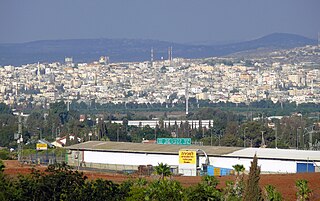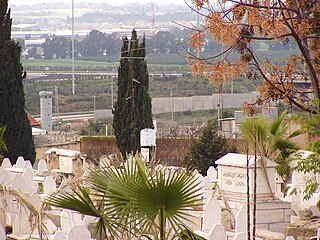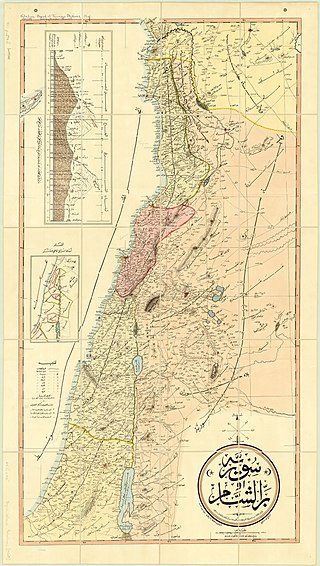Related Research Articles

Tulkarm or Tulkarem is a Palestinian city in the West Bank, the capital of the Tulkarm Governorate of the State of Palestine. The Israeli city of Netanya is to the west, and the Palestinian cities of Nablus and Jenin to the east. According to the Palestinian Central Bureau of Statistics, in 2017 Tulkarm had a population of 64,532. Tulkarm is under the administration of the Palestinian National Authority.
The population of the region of Palestine, which approximately corresponds to modern Israel and the Palestinian territories, has varied in both size and ethnic composition throughout the history of Palestine.
Hanna Batatu was a Palestinian Marxist historian specialising in the history of Iraq and the modern Arab east. His work on Iraq is widely considered the preeminent study of modern Iraqi history.

The Jenin Governorate is one of 16 Governorates of Palestine. It covers the northern extremity of the West Bank, including the area around the city of Jenin, which is the district capital or muhfaza of the district.

The Nablus Governorate is an administrative district of Palestine located in the Central Highlands of the West Bank, 53 km north of Jerusalem. It covers the area around the city of Nablus which serves as the muhfaza (seat) of the governorate. The governor of the district is Mahmoud Aloul.

The Qalqilya Governorate or Qalqiliya Governorate is an administrative area of Palestine in the northwestern West Bank. Its capital or muhfaza (seat) is the city of Qalqilya that borders the Green Line.

The Tubas Governorate is an administrative district of Palestine, in the northeastern West Bank. Its district capital or muhfaza is the city of Tubas. In 2007, the population was 50,267, raising to 60,927 in 2017.

The Tulkarm Governorate is an administrative district and one of the 16 Governorates of Palestine, located in the north-western West Bank. The governorate's land area is 268 square kilometres. According to the Palestinian Central Bureau of Statistics, the governorate had a population of 172,800 inhabitants. The muhafaza or district capital is the city of Tulkarm.

Sajad was a Palestinian village in the Ramle Subdistrict. It was located sixteen kilometers south of Ramla. Sajad was established in the late 19th century near a local train station. It was depopulated during the 1948 Arab–Israeli war.
Saffarin is a Palestinian village in the western West Bank, in the Tulkarm Governorate of the State of Palestine, located 11 kilometers South-east of Tulkarm. According to the Palestinian Central Bureau of Statistics, Saffarin had a population of approximately 1,037 inhabitants in mid-year 2006 and 754 by 2017. 9.8% of the population of Saffarin were refugees in 1997. The healthcare facilities for Saffarin are designated as MOH level 2.

The Nablus Sanjak was an administrative area that existed throughout Ottoman rule in the Levant (1517–1917). It was administratively part of the Damascus Eyalet until 1864 when it became part of Syria Vilayet and then the Beirut Vilayet in 1888.

Gentry are "well-born, genteel and well-bred people" of high social class, especially in the past. Gentry, in its widest connotation, refers to people of good social position connected to landed estates, upper levels of the clergy, or "gentle" families of long descent who in some cases never obtained the official right to bear a coat of arms. The gentry largely consisted of landowners who could live entirely from rental income or at least had a country estate; some were gentleman farmers. In the United Kingdom, the term gentry refers to the landed gentry: the majority of the land-owning social class who typically had a coat of arms but did not have a peerage. The adjective "patrician" describes in comparison other analogous traditional social elite strata based in cities, such as the free cities of Italy and the free imperial cities of Germany, Switzerland, and the Hanseatic League.
Sharqliyya is a village in central Syria, administratively part of the Homs Governorate, located northwest of Homs. Nearby localities include al-Qabu and al-Shinyah to the west, al-Taybah al-Gharbiyah to the northwest, Taldou to the northeast and Ghur Gharbiyah to the east.

Ehud R. Toledano is professor of Middle Eastern history at Tel Aviv University and the current director of the Program in Ottoman & Turkish Studies. His areas of specialization are Ottoman history, and socio-cultural history of the modern Middle East.
A Palestinian family is a large community of extended family members with a lineage that can be traced to ancestors who resided in Palestine. Socially, these families are divided according Segmentary lines, and socio-spatial associations as city dwellers, villagers and nomads. The elites, traditionally known as the notables, headed these families, and specialized in specific occupations. For example, urban elites traditionally made of city-dwelling merchants (tujjar), clerics ('ulema), ashraf, military officers, and governmental functionaries, the rural notability was composed of rural sheikhs, village or clan mukhtars.
The Ayan was the class of local notables or dynasts in the 16th to the early 19th century Ottoman Empire who held varying degrees of authority in provincial towns and districts. The a'yan had significant autonomy, and even armed force, but did not challenge the central Ottoman government. Though the title was awarded only to Muslims, its function was secular. The a'yan included "wealthy merchants, heads of Janissary garrisons, leaders of important craft guilds, those who had bought the right to collect taxes for the government in Istanbul, and those who supervised the distributions of wealth generated by, and the maintenance of, pious endowments." The rise of the a'yan class was part of the decentralizing trend in the Ottoman Empire which began in the 16th century, and came to define the Empire's structure until its fall in the early 20th century.

The Syrian Peasant Revolt was an armed uprising of Levantine peasant classes against the rule of Ibrahim Pasha of Egypt in 1834–35. The revolt took place in areas of Ottoman Syria, at the time, ruled by the semi-independent ruler of Egypt, who conquered the region from loyal Ottoman forces in 1831.
Samad is a village in southern Syria, administratively part of the Daraa Governorate, located east of Daraa and immediately southeast of Bosra. Other nearby localities include al-Qurayya to the northeast, Hout to the east and Dhibin to the southeast. According to the Syria Central Bureau of Statistics (CBS), Samad had a population of 3,098 in the 2004 census.
Jamrin is a village in southern Syria, administratively part of the Daraa Governorate, located east of Daraa and immediately north of Bosra. Other nearby localities include Maaraba to the west, Kharaba to the northwest, al-Mujaymer to the north and al-Qurayya to the east. According to the Syria Central Bureau of Statistics (CBS), Jamrin had a population of 1,000 in the 2004 census.
The study of the origins of the Palestinians, a population encompassing the Arab inhabitants of the former Mandatory Palestine and their descendants, is a subject approached through an interdisciplinary lens, drawing from fields such as population genetics, demographic history, folklore, including oral traditions, linguistics, and other disciplines.
References
- ↑ Batatu, Hanna (2012-09-17), "Syria's Peasantry, the Descendants of Its Lesser Rural Notables, and Their Politics", Syria's Peasantry, the Descendants of Its Lesser Rural Notables, and Their Politics, Princeton University Press, doi:10.1515/9781400845842/html, ISBN 978-1-4008-4584-2 , retrieved 2024-05-03
- ↑ "Landed Property and Elite Conflict in Ottoman Tulkarm". Institute for Palestine Studies. Retrieved 2024-05-03.
- 1 2 Marom, Roy (April 2024). "The Palestinian Rural Notables' Class in Ascendency: The Hannun Family of Tulkarm (Palestine)". Journal of Holy Land and Palestine Studies . 23 (1): 77–108. doi:10.3366/hlps.2024.0327. ISSN 2054-1988 – via Academia.
- ↑ Gilbar, Gad (2022-10-31). Trade and Enterprise: The Muslim Tujjar in the Ottoman Empire and Qajar Iran, 1860-1914. London: Routledge. doi:10.4324/9781003177425/trade-enterprise-gad-gilbar. ISBN 978-1-003-17742-5.
- ↑ Gelvin, James L. (2006). "The "Politics of Notables" Forty Years After". Middle East Studies Association Bulletin. 40 (1): 19–29. ISSN 0026-3184.
- ↑ Cleveland, William L. (1989). Muslih, Muhammad Y. (ed.). "Politics of the Notables". Journal of Palestine Studies. 18 (3): 142–144. doi:10.2307/2537348. ISSN 0377-919X.
- ↑ Toledano, Ehud R. "Ehud R. Toledano, "The Emergence of Ottoman-Local Elites (1700-1800): A Framework for Research," in I. Pappé and M. Ma'oz (eds.), Middle Eastern Politics and Ideas: A History from within, London and New York: Tauris Academic Studies, 1997, 145-162".
{{cite journal}}: Cite journal requires|journal=(help) - ↑ "The Dynamics of Palestinian Elite Formation". Institute for Palestine Studies. Retrieved 2024-05-03.